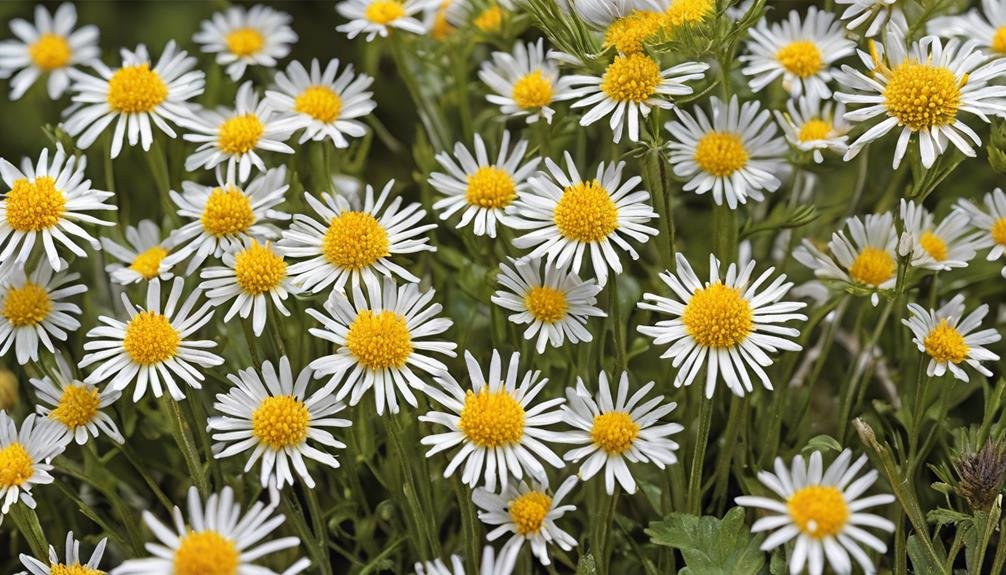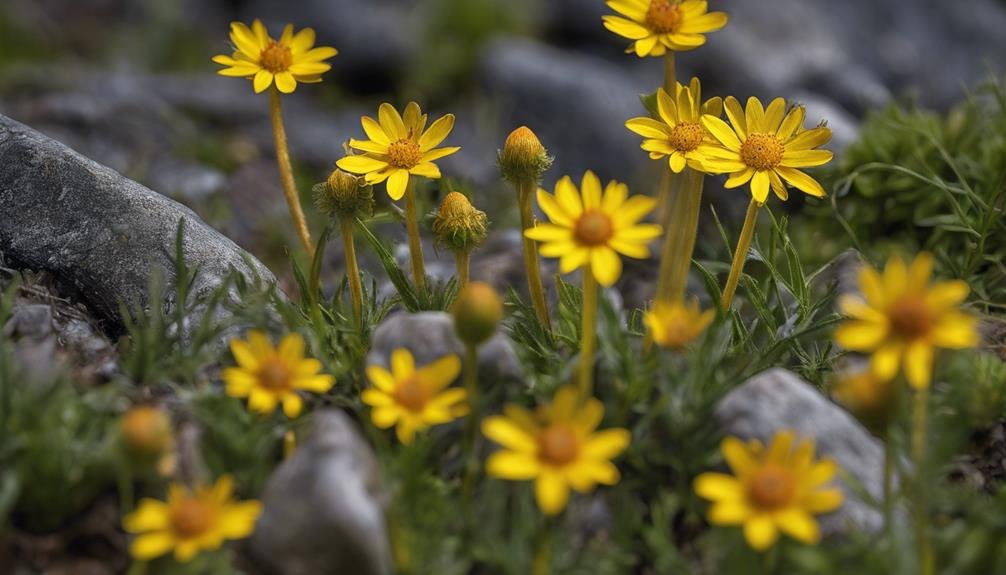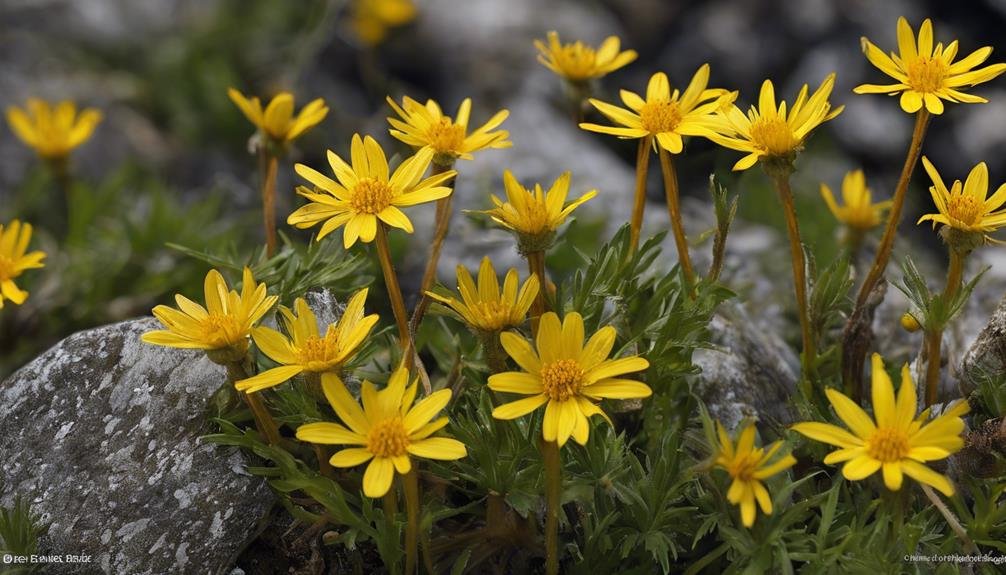Why is the Alpine Arnica noteworthy in discussions about conservation and biodiversity? This question leads us to explore the unique characteristics and challenges faced by Arnica angustifolia, a species that exemplifies nature’s ability to adapt and flourish in specific, often harsh environments.
Alpine Arnica, a member of the Asteraceae family, is distinguished by its ability to thrive in mountainous terrains. Its survival and proliferation in such rugged landscapes underscore the plant’s remarkable adaptability. The flowers of the Alpine Arnica are not only aesthetically pleasing but also play a crucial role in attracting a specialized group of pollinators, which is essential for the reproduction of the species.
However, maintaining the population of Alpine Arnica is faced with significant hurdles. The conservation status of this plant highlights the need for dedicated research and proactive engagement with conservation bodies. These actions are vital for mitigating threats to its natural habitat and ensuring the continued existence of Alpine Arnica.
This scenario underscores the broader implications for biodiversity conservation and the intricate challenges involved in protecting species that, while resilient, are also incredibly delicate.
Key Takeaways
Alpine Arnica (Arnica angustifolia) stands out in the Asteraceae family due to its unique floral attributes and adaptation to mountainous terrains. This plant not only adds beauty to its surroundings but also plays a pivotal role in ecosystem dynamics by attracting pollinators.
Facing endangerment, Alpine Arnica underscores the urgency for conservation measures. Collaborative research and targeted conservation strategies are imperative for its preservation, which is essential for maintaining biodiversity and ecological balance in its native habitats.
Key Takeaways:
- Alpine Arnica is recognized for its unique flowers and adaptation to mountain environments.
- It significantly contributes to ecological balance by attracting pollinators.
- The species is endangered, necessitating immediate conservation efforts.
- Preserving Alpine Arnica is crucial for sustaining biodiversity and ecological stability.
Arnica’s Alpine Beginnings
Alpine Arnica’s Ecological Role and Conservation
In the heart of specific alpine regions, the Alpine Arnica (Arnica angustifolia) thrives, adapting to its harsh environments with remarkable resilience. This species, native to these locales, has piqued interest due to its ecological importance and distinctive attributes. The work of Lampinen and Lahti in 2021 meticulously charts the distribution of this plant, shedding light on its presence across varied landscapes. This detailed mapping is more than a geographical exercise; it’s a critical tool for conservation efforts, ensuring that strategies to protect this species are informed and effective.
Identification and Research
The NatureGate website, serving as a digital Field Guide, recognizes Alpine Arnica as a key player in the biodiversity of alpine ecosystems. This platform provides extensive details for identifying the species, emphasizing its unique place among other flora. Such categorization isn’t merely academic; it’s a resource for conservationists and researchers dedicated to the species’ survival. The focus on Alpine Arnica extends beyond mere observation, encouraging a proactive approach to understanding its needs and threats.
Conclusion: Ensuring Alpine Arnica’s Future
The collective effort to map, study, and conserve Alpine Arnica underscores a broader commitment to preserving biodiversity. Each step, from identification to conservation planning, is crucial for the well-being of this unique alpine inhabitant. The insights provided by researchers and platforms like NatureGate form the foundation of a comprehensive strategy aimed at safeguarding Alpine Arnica for future generations. Through continued research and targeted conservation, the hope is to maintain the ecological balance and the beauty of the alpine regions that this species calls home.
Flower Characteristics

Alpine Arnica Floral Anatomy
The Alpine Arnica presents a fascinating study in floral architecture with its composite structure. At the heart of its appeal lies the intricate arrangement of ray and disc florets. Each flower head is a bouquet in itself, composed of numerous small flowers designed to mimic a single, large bloom. This ingenious design not only contributes to the plant’s aesthetic appeal but also to its efficiency in attracting pollinators.
Vibrant Hues of the Alpine Landscape
The bright yellow petals of the Alpine Arnica serve as a beacon against the green backdrop of alpine meadows. While this vivid color is the most common, the plant occasionally surprises with hues that deviate from this norm. These splashes of color play a vital role in the visual language of nature, signaling availability to pollinators from afar.
Elevated Blooms: Growth Patterns in the Alpine Arnica
One can’t overlook the long stalks that elevate the Alpine Arnica’s blooms above the surrounding vegetation. This strategic growth pattern ensures that the flowers are prominently displayed, maximizing exposure to sunlight and visibility to pollinators. It’s a testament to the plant’s adaptive strategies for survival and reproduction in challenging environments.
The Essence of Attraction: Pollinator Interactions
The Alpine Arnica’s fragrance is as important as its visual allure in the ecological dance of pollination. This scent serves as an olfactory signal to bees and butterflies, guiding them to the source of nectar. The relationship between the Alpine Arnica and its pollinators is a classic example of co-evolution, highlighting the interconnectedness of life in alpine ecosystems.
Exploring the Alpine Arnica reveals a world of complexity and beauty, ingeniously adapted to thrive in its high-altitude home. From its composite flower structure to its strategies for attracting pollinators, the plant is a vibrant contributor to the biodiversity of alpine landscapes.
Mountain Ranges Presence

Adaptability Across Elevation: Arnica angustifolia in Mountainous Regions
Delving into the ecological niche of Arnica angustifolia, its thriving presence in mountain ranges like the Rocky Mountains, Cascade Range, and Sierra Nevada is a testament to its remarkable adaptability to varied high-altitude environments. This species has mastered the art of survival and distribution across elevations, predominantly above the tree line, where it faces the harsh conditions of mountainous terrains.
Habitat Preferences and Ecological Contribution
The distribution of Alpine Arnica across these mountain ranges is a deliberate selection, driven by its preference for cool, high-altitude climates and well-drained soils. This preference not only underscores the plant’s ecological niche but also its significant contribution to the biodiversity and ecological richness of these areas. The species’ ability to navigate and thrive in the rugged landscapes of the Rocky Mountains, Cascade Range, and Sierra Nevada is indicative of its evolutionary success in elevation adaptation.
Enriching High-Altitude Ecosystems
Arnica angustifolia’s role in the ecosystems of these regions is profound. Its presence enhances the ecological diversity, particularly in alpine and subalpine habitats, which are a prominent feature of North America’s mountainous topography. Occupying these specialized niches, Alpine Arnica plays a crucial role in the ecological dynamics of high-altitude environments, contributing to the overall health and richness of these ecosystems.
Pollinator Attraction Mechanisms

Visual Attraction through Color
Arnica angustifolia stands out in its alpine environment with bright yellow flowers, a stark contrast to the surrounding greenery. This vivid coloration isn’t just for show; it acts as a beacon, drawing in bees and butterflies on the hunt for food. The yellow hue is specifically tailored to catch the eye of these pollinators, guiding them towards the plant for a mutually beneficial interaction.
Guidance with Nectar Guides
The petals of Arnica angustifolia aren’t only brightly colored but also feature nectar guides. These are essentially nature’s landing strips, leading pollinators directly to the plant’s reproductive organs. This clever design ensures that visitors don’t wander aimlessly but instead make a beeline for where they can be most beneficial to the plant’s pollination process.
Scent and Nectar Production
To further entice its winged guests, Arnica angustifolia emits a sweet scent and produces nectar, a favorite treat of many insects. This fragrance and reward system not only draws pollinators from afar but also encourages them to linger. The longer a pollinator stays, the higher the chance it will pick up pollen and carry it to the next flower, increasing the plant’s opportunities for successful reproduction.
Pollinator-Friendly Flower Structure
The structure of Arnica angustifolia’s flowers is designed for easy access to nectar and pollen, accommodating the needs of its pollinators. This approachable design ensures that visitors can efficiently gather food while simultaneously getting coated in pollen. It’s a win-win situation where the plant gets pollinated, and the insects get fed without unnecessary hassle.
Synchronized Bloom Period
Timing is everything for Arnica angustifolia. Its flowering period is perfectly synchronized with the peak activity of its primary pollinators. By blooming when bees and butterflies are most active, the plant ensures a higher likelihood of visitor traffic and, consequently, successful pollination. This timing strategy is a subtle yet powerful demonstration of nature’s interconnectedness, where the survival of one species is intricately linked to the behavior of another.
Endangered Status Overview

Conservation Urgency for Alpine Arnica
The ecological importance of Arnica angustifolia is undeniable, yet its endangered status signals a pressing need for conservation measures. Alpine Arnica grapples with decreasing habitats, a situation exacerbated by human and natural activities. The species faces serious threats from overgrazing, land development, and the adverse effects of climate change. These challenges highlight the importance of immediate and focused conservation initiatives to ensure the survival of this vital species.
The Role of Population Monitoring
Understanding the population trends of Alpine Arnica is paramount for its conservation. Through diligent population monitoring, conservationists gain critical insights into the species’ health and areas requiring urgent conservation action. This data-centric approach enables the development of targeted strategies to combat the decline of Alpine Arnica, ensuring efforts are both efficient and effective.
Habitat Restoration Strategies
Restoring the natural habitats of Alpine Arnica is a fundamental aspect of its conservation strategy. Efforts to rehabilitate lands impacted by human activities and environmental shifts are key to providing a safe haven for these plants. The significance of habitat restoration lies not only in promoting ecological balance but also in preserving the genetic diversity of Alpine Arnica, which is vital for its future adaptability.
Collaborative Conservation Efforts
The survival and recovery of Alpine Arnica greatly benefit from partnerships with conservation organizations. These collaborations are instrumental in pooling resources and expertise, thereby enhancing the effectiveness of conservation measures. Working together, stakeholders can ensure the long-term preservation of Alpine Arnica in its natural habitat, securing its role in the ecosystem for generations to come.
Frequently Asked Questions
What Is Alpine Arnica?
What is Alpine Arnica and where does it grow?
Alpine Arnica is a plant with known medicinal properties, playing a vital role in its ecosystem. It flourishes in specific habitats that support its growth, making it a key species for biodiversity and conservation efforts.
How does Alpine Arnica contribute to its ecosystem?
Alpine Arnica contributes to ecosystem diversity by supporting a range of wildlife and plant species. Its presence is indicative of a healthy environment, and it plays a role in habitat sustainability.
Why are conservation efforts important for Alpine Arnica?
Conservation efforts are important for Alpine Arnica to maintain its population and habitat. Due to its specific growth requirements, it is vulnerable to environmental changes, making targeted conservation strategies crucial for its survival.
What Is the Common Name for Arnica Montana?
Q: What is the common name for Arnica Montana?
A: The common name for Arnica Montana is Mountain Daisy. It is known for its anti-inflammatory properties and is commonly used in herbal medicine for pain relief and recovery.
Is Arnica Native to North America?
Is Arnica Native to North America?
Yes, Arnica is indeed native to North America. It thrives in the cold, rocky terrains of its alpine habitats, which are essential for the biodiversity of the local ecosystems. Conservation efforts are in place to protect these areas and the plants that inhabit them.
How Do I Identify Arnica Montana?
Q: How can I identify Arnica Montana?
A: To spot Arnica Montana, look for its bright yellow, daisy-like flowers and a unique floral scent. This plant thrives in mountainous, acidic soils. Its leaves are oblong with toothed margins and are known for their anti-inflammatory properties.
Do Alpine Arnica and Labrador Tea Have Similar Medicinal Uses?
Alpine arnica and Labrador tea both have traditional roles in herbal medicine for treating inflammation and pain relief. However, their specific applications differ. While Alpine arnica is often used for bruises and muscle pain, the labrador tea plant is commonly brewed to help with respiratory issues and soothe digestion concerns.
Do Mountain Avens Share Any Medicinal Properties with Alpine Arnica?
Mountain avens and alpine arnica both thrive in alpine conditions, but their medicinal uses differ. While alpine arnica is well-known for treating inflammation and bruises, mountain avens are primarily ornamental. However, exploring mountain avens facts shows little evidence supporting significant medicinal properties comparable to alpine arnica’s.
Conclusion
Alpine Arnica (Arnica angustifolia) is a notable member of the Asteraceae family, distinguished by its distinct floral characteristics and its ability to thrive in specific mountain environments. Its significance extends beyond its beauty, playing a crucial role in attracting pollinators and contributing to the ecological dynamics of its habitat.
The species is currently facing threats that place it in an endangered status, highlighting the need for immediate conservation actions. Efforts to safeguard Alpine Arnica involve collaborative research and the implementation of effective conservation strategies. The preservation of this species is vital for sustaining biodiversity and ensuring ecological stability in the areas it inhabits.


